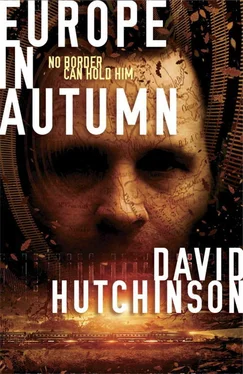Clearly, it would have been impossible for one man to undertake such a survey on his own, and there are records surviving in Cumbria, Peeblesshire and Kent which suggest that the General hired local men where it was possible, while keeping a firm hand on the overall control of the project.
In many areas this contracting-out of the work may account for the friction reputed to have existed between Whitton-Whyte and the Ordnance Survey, which in a number of instances was surveying for its own maps at the same time as the General’s men were surveying for his. It’s said that on several occasions this friction erupted in violence.
There is a story, retold in Grey’s Maps and Mapmakers Of The British Isles (Pitt & Sefton, 1892), relating to the theft of Ordnance Survey field drawings of Cornwall and noting – though there is no evidence that they were responsible – that Whitton-Whyte’s Survey was known to be in the same area at the same time as the Ordnance men.
Comparison of publication dates, says Grey, reveals that Sheet 178923 of the Alternative Survey (Northern Cornwall) was published in less than half the time of the other sheets. However, it should be noted that, save for Sheet 2000, no records of publication dates have survived to the present day, and therefore it is impossible to authenticate Grey’s thinly-veiled accusation.
In total, the Alternative Survey lasted one hundred and twenty years. In his scholarly work Mapa i Pamięc (Map And Memory) (Zakopane, 1920) Walerian Mazowiecki even blames the Survey for the eventual downfall of the Whitton-Whyte family.
Only one full set of the Survey was ever collected, these stored in the ‘Map Room’ of the Whitton-Whytes’ townhouse in Islington. All but one version of Sheet 2000 – which was on loan to Mr S. J. Rolfe of the British Museum at the time – were destroyed, along with the rest of the collection, when the house burned down in July 1912, and our subsequent knowledge of its history has been gleaned from examination of surviving notes and field drawings.
SURVEY
As with so many of the other sheets of the Alternative Survey, the survey of Sheet 2000 is based on existing data. It used the Hounslow Heath baseline measured by General William Roy in 1784. Whitton-Whyte is said to have remeasured the baseline a month later, and pronounced it ‘adequate.’ Thereafter, this sheet, covering the area to the west of London, conforms in general to the triangulations which resulted in Ordnance Survey Sheet 7. Whether Whitton-Whyte actually made any measurements of his own beyond checking Roy’s baseline is a matter of conjecture.
DRAWING AND ENGRAVING
It is believed from contemporary accounts that twelve field drawings were prepared for draughtsmen in late August 1820, when proof copies of Ordnance Survey Sheet 7 were already circulating. Whether any of these proofs fell into the hands of the Whitton-Whyte Survey is not known.
What is known is that Henry Hoskyns, who undertook the reduction of the field drawings to a form ready for engraving, made a flurry of revisions at the end of August, and was heard by his apprentice, James Summers, to exclaim that the detail of the drawings was ‘as inaccurate as it is possible to be.’
This outburst, and the subsequent revisions, led to Whitton-Whyte breaking off all relations with Hoskyns – who had been involved in the draughting of virtually all the Alternative Survey sheets, man and boy. Hoskyns, his eyesight already failing, became totally blind later that year, and, unable to work, was buried in a pauper’s grave when he died six years later.
It’s said that, following the disagreement with Hoskyns, Whitton-Whyte himself reinstituted the original state of the map and delivered the draught in person to its engraver, Mortimer Heathcoate, charging him to ‘change not one line nor one triangulation point.’
PUBLICATION HISTORY
General Whitton-Whyte never lived to see the publication of Sheet 2000. In September 1822, aged eighty, he suffered a stroke while travelling through Dorset, and died at Poole two days later. It is a testimony to the old man’s stamina that, despite the difficulties of travel around England, Scotland and Wales in those days, he had managed to cover so much of the country during his life.
The Survey was not delayed by mourning, however, and Sheet 2000, now overseen by Whitton-Whyte’s son, Captain John, was published as a single sheet in London on October 5, 1822, some two months after the Ordnance Survey sheet of the same area.
Comparison of the two sheets shows that Hoskyns’ reservations about the accuracy of Sheet 2000 were largely unfounded, save in one area just north of Colnbrook, where the village of Stanhurst is marked. No such village appears on the OS sheet, and indeed no such village has ever existed in this location.
Quite where the inaccuracy came from is unknown, and the surviving field drawings offer no clue. It is known that, despite his advanced years, the General made many on-site surveys himself. Whether he mapped ‘Stanhurst,’ or whether one of his hired men made this inexplicable error, is not known. However, due to Whitton-Whyte’s dispute with Henry Hoskyns, the error was allowed to stand.
1Sheet 2000 was revised by Captain John Whitton-Whyte in 1830 and 1831, the revised state being published in 1833. This revision was undertaken to bring the sheet into line with the James Gardner printings of OS Sheet 7 between 1824 and 1840, and exhibits many of the Gardner revisions.
However, far from removing the spurious village of Stanhurst from the original state, the revision shows it as having grown in size and been joined by a neighbouring hamlet named Adam Vale, on the outskirts of Colnbrook. A contemporary account tells of Captain John taking ‘a particular interest’ in this portion of the map, and spending many weeks in the Windsor area, where he died of pneumonia in December 1842.
2With the death of Captain John, his son, Lieutenant Charles Whitton-Whyte, then twenty-two years of age, found himself in charge of the Alternative Survey, overseeing new revisions and the first electrotype printings of Sheet 2000.
The first electrotype printing was published in 1849, and instead of correcting the errors in its predecessors, compounds them. Surviving field drawings show an increase of interest in the area around Windsor, and a corresponding decline of accuracy elsewhere on the sheet. The 1849 printing of Sheet 2000 therefore largely resembles the 1833 state, save in one area.
The 1849 state erases Colnbrook altogether, replacing it with an Adam Vale the size of a small town. Stanhurst’s cathedral (St Anthony’s) is recorded in one set of field drawings, while in another set the spurious villages of Vale, Minton and Holding have obliterated Harmondsworth.
By the revisions of 1851 and 1855, this small corner of Middlesex is all but unrecognisable. Spurious villages, hamlets and towns have sprung up seemingly overnight. West Drayton has gone, and all that marks its former position on several sets of field drawings is the legend ‘Drew Marsh’ and the symbol for a large pond.
From the few surviving records, it appears that the rest of the map, while perfectly accurate, was to all practical purposes ignored, being reproduced from earlier sheets or (some accounts have it) from Ordnance Survey sheets.
The quite imaginary area around Stanhurst appears to have obsessed Charles Whitton-Whyte, a reclusive man by all accounts, presiding over a family fortune mortally damaged by the cartographical endeavours of his father and grandfather. In 1846, he resigned his commission in order to devote his time to map-making.
Charles took to spending much of his time in Windsor while various family holdings fell into decline due to his neglect. At the time of the 1855 revision, he bought a small house in Datchet, and is reported to have spent many hours walking in a countryside which, according to his map, did not exist.
Читать дальше







